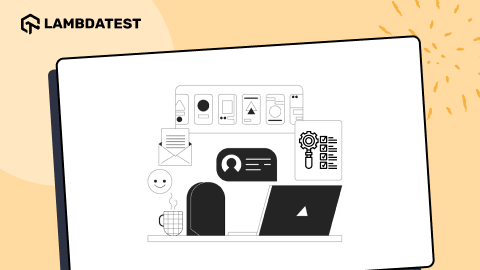What Is Usability Testing And Why You Need It?
Deeksha Agarwal
Posted On: July 6, 2018
![]() 42203 Views
42203 Views
![]() 9 Min Read
9 Min Read
Usability testing, as the name goes, is the testing of a website or an application for its usability. By usability one might confuse it for an ‘ease of use’ of any website or product , but it’s not limited to just that. Usability is a wide term and there is a lot more to it but don’t worry at the end of this blog, you’ll be clear with every point of usability and mobile usability testing.
Before going into details of usability testing, you need to be aware of what usability is and why does it matter. As per ISO, one might think of usability as:
The extent to which you can use a product to achieve goals effectively, efficiently, and with proper satisfaction in a certain context of use of a product.
These lines define the core underlying spirit behind usability testing. No matter the product or product use case, even if the parameters defining the usability of a product will change, the key characteristic and the underlying principle behind usability testing remains the same.
If explained in brief, usability testing:
- is highly concerned with user satisfaction, irrespective of the product requirements, engineering used, and other factors considered while building the specific product. It is like performing a black box testing of a product just to gather the ease of use, effectiveness, efficiency, and satisfaction related to the product’s usage.
- is related to how usable the product or website is. If some website has to be usable, it has to be engaging and pleasing, and at the same time perform the intended task in as intuitive and efficient way possible.
TABLE OF CONTENTS
Why We Need To Be Concerned About Usability?
As per the latest stats:
- 46% of the people leave a website after getting an unclear picture of what your website does.
- 44% of people leave a website as they find insufficient contact information in the website.
- 37% people decide to never come back to a website because of poor design or bad navigation.
And the ratio of these bounce backs is quite high. Any business cannot afford to lose this portion of the audience hence it becomes necessary to perform usability testing and making sure that you won’t miss out on such high number of your website visitors.
In other words, If a user visits your website and it fails to meet their goals in an intuitive, efficient, and satisfactory manner what will they do?
Go for its competitors!
User experience is one of the most important if not the most important aspect of making an online business successful. And that’s what is measured under the scope of Usability Testing.
So, What All Is To Be Tested For Testing Usability Of A Product?
In simple terms, when you are testing for usability, you need to test for 5Es namely:
- Effectiveness
- Efficiency
- Engagement
- Error Tolerance
- Ease of Learning
So, let’s get into details of these 5Es. What they mean and what all you’ll be testing for them?
Also check out Top Usability Testing Tools For Your Website
1. Effectiveness
Effectiveness means whether the user will be able to achieve the goal accurately or not.
When performing usability testing, you need to make sure that your website/ product actually solves the core user problem or not.. The scope of this testing ranges from features, functionality, to even content. In features part is easy to understand. The product should have the critical features to solve the problem that has been advertised by promoters Here promoters can be a website, social media, person, etc. In other words face of the product that is being marketed to bring users on board.
The same goes for content. You need to use a clear and simple language in order to make sure that your message is clear to the user and the language is pretty easy to understand.
Now that you have a feature set, you need to make sure that these features works as intended. And that’s what is covered under functionality testing.
2. Efficiency
Efficiency is highly concerned with the speed of achieving a certain goal. The faster you achieve a goal, the more efficient you are.
For any website, you can measure efficiency in terms of number of keystrokes required to achieve a certain goal. Less number of keystrokes with clarity and achievable goal is considered highly efficient.
Navigation is one of the factors determining the efficiency. How intuitive the website’s navigation is? Do users feel confused or find it tiring while navigating from one page to another? How many pages the user has to go through while completing a certain goal?
For example: If you went to an ecommerce website to purchase a pair of sunglasses. What will be your workflow?
- Login to the Web Portal
- Search Sunglasses in the search box
- Click on Search results to find the relevant sunglasses for you
- Go to cart
- Move to checkout
- Redirected to payments page
- Add pin, OTP, or other authentications
- An invoice will be finally generated along with product delivery and tracking details
So, if you analyze it you’ll find out that it involves 8 page navigation to attain that particular goal plus it sends you in another workflow of shipping and tracking for finally receiving the product. In this case, it’s an ideal scenario however, if some unnecessary navigation pages are there, there is a need to decrease that and make it as minimum as possible. Shortcuts also adds to the efficiency of a product or website. So check for all the shortcuts and all possible ways to speed up the user’s goal attaining pace. This enhances the user experience and saves his time and efforts making it more usable.
Latest advanced websites deliver web pages to users based on their past usage pattern to get a better conversion. For example, suppose the user has not selected a sunglasses in the above scenario, the website will now show sunglasses as default products in homepage on user’s next visit. Maybe highlighting any ongoing offer or any new addition to the product list.
3. Engagement
By engagement we mean the capacity of tending the user to stay on our product or website as maximum as possible. It is a quantitative field to be tested.
This can be affected by minute elements like design elements, good visuals, better graphics, micro-interactions, chat-bots, surveys,etc. Aesthetics plays a major role in keeping a user engaged. The way you present your product or website also gives you an edge over engagement.
So, you need to test this by keeping a check on time, what all things are there on a website or a product that are increasing the interaction time on a website. Make sure that interaction time is increased because of user’s interest and not because of the problems holding him back to take any action. You need to keep an eye on bounce rate, average session time, and total number of sessions. For products you also need to keep track of engagement cohorts.
Engagement is about looking nice and right at the same time. So you need to test for all the nice and right elements.
4. Error Tolerance
It relates with how can you minimize errors from occuring in your website or product. Some small small inclusions like undo, redo, etc can help you making your website error tolerant.
Make sure whenever, something can happen by mistake, do you have any ‘get back to original’ option for that? It will add to the usability of your product. So, to test for it, try every possible mistakes that you can do and is there a way to recover them?
5. Ease of Learning
That is also one of the most important things to be tested for usability. Ease of learning means how easily are your users learning to use your new product and feature updates.
For example, your users were loving your product’s current version and an update changed the way it works. Now there might be a possibility that the new version is disliked by them as they are unable to understand how they have to use it now.
So, before making any release to the market or making it available for the users, perform a through testing from an end user’s perspective.
The major problem that occurs while doing so is that we can’t make out what all possibilities can there be available for our user. He might be a beginner, intermediate, and an expert so while performing usability testing, we have to take care of all the possible scenarios and make our product up to their expectations.
What Are The Major Advantages Of Performing Usability Testing?
When you perform usability testing, you’ll
- check if the product meets the user expectations or not
- make sure that the business decisions are matching the real world use
- find out flaws in the product before the users find them
- get a clear picture of how successful your users are when performing tasks
- get feedbacks for your product and improve your product for better usability.
Once you’re clear on what is usability and what and why we need to perform usability testing, you now need to create a time saving and effective usability testing strategy. Well that’s too much to digest in a single time so I’ll help you with this problem in the next blog. Till then Ciao and Happy testing!
Got Questions? Drop them on LambdaTest Community. Visit now
















